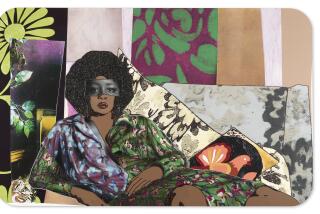ART REVIEW : Intimate Look at Thomas Gainsborough
“Gainsborough and the British Landscape Tradition” is a small, focused exhibition that promises more than it delivers. Rather than offering its visitors an adequate introduction to a tradition that spans more than three centuries, it presents just a glimpse of this historic genre of painting.
We get less of a picture of Gainsborough’s place in the history of British landscape painting than an idea of the relationship between his preparatory drawings and his more resolved paintings.
Even so, the show at the Huntington Art Gallery does not disappoint. It is an instructive, scholarly study of a responsible selection of Thomas Gainsborough’s (1727-1788) drawings and prints, most dating from the last decade of his life.
Like most drawing exhibitions, this one offers insights into the artist’s process of working and thinking. More tentative and exploratory than oils-on-canvas, drawings provide a sense of intimacy and detail that gives us a feel for the artist’s “touch.”
In Gainsborough’s case, this is doubly true. He is most well known for his stuffy, formulaic portraits of aristocrats, the Royal Family and wealthy businessmen. His full-length depiction of Jonathan Buttall, “The Blue Boy,” is a prized feature of the Huntington’s art collection, purchased in the early 1920s when a nostalgic vision of 18th-Century “rugged elegance” was all the rage among American millionaires.
For Gainsborough, commissioned portraits simply paid the bills. “To pick pockets in the portrait way” was how he described this side of his art. It allowed him to pursue what he felt was his true artistic vision.
He painted landscapes for his own aesthetic pleasure, or to fortify his reputation in the Royal Academy (of which he was a founding member in 1768). Images of the English countryside--of rustic cabins, farmers leading their carts to market or cattle to water, and riders following winding roads through woods and over bridges--belong to the romantic side of his art.
*
The drawings and sketches he made as studies for these paintings rank among his most free, most revealing works. Unconstrained by the marketplace, and undertaken only for the satisfactions they delivered, they represent an emergent strand of expressive individualism, one that would blossom, over the next explosive decades, into British Romanticism.
Gainsborough rejected the specificity and precision that characterized the landscapes of his contemporaries. He often built little dioramas out of moss, rocks, twigs, glass and broccoli--and sketched by candlelight to achieve his fanciful and often charming compositions.
As an effective point of contrast, the exhibition includes works by some lesser artists, such as George Barret, Paul Sandby and Richard Wilson, who also founded the Royal Academy, as well as Richard Cooper and Alexander Cozens. Gainsborough’s works share little with their sharp, topographical images. His landscapes are dreamy and idealized, not in the classical sense of possessing balance and clarity, but in the modern sense of embodying emotional resonance. They are picturesque celebrations of detailed textures and flickering sunlight.
The exhibition also includes a few of the artists who influenced Gainsborough and some who built on his achievement. Tiny etchings by 17th-Century Dutch Naturalists, such as Nicolaes Berchem, Jan Both, Jacob van Ruisdael and Anthonie Waterloo, suggest possible sources of motifs and inspiration. A crisp etching by Claude Lorrain serves as a model for composition, if not style.
A sketch attributed to John Constable and single watercolors by Thomas Girtin and J.M.W. Turner offer a hint of the direction in which the next generation of British landscape painters took Gainsborough’s evocative, personal works. But this component of the show remains the least persuasive, providing barely a sketch of some connections and ignoring many of Gainsborough’s more powerful influences, such as Van Dyck, Watteau, Hogarth, Rubens, Rembrandt and Murillo.
“Gainsborough and the British Landscape Tradition” is most successful when it focuses on his work alone, offering a thorough, intimate view of the processes that led to his oils-on-canvas. A single, exemplary painting of a farmer leading his cart to market is the centerpiece of the exhibition. A larger, more accomplished, dramatic and sentimental landscape is on permanent display downstairs in the main gallery.
In both paintings, Gainsborough depicts the solid earth on which his figures stand as if it were a choppy, tumultuous sea. Farmers’ cottages and carts are not only dwarfed by the implied vastness, but threatened by the land’s capacity to swamp them. Gainsborough’s drawings and prints offer ample evidence of his fascination with instability and tempestuousness, grounding his paintings in an essentially Romantic, nearly modern vision of a world held in tension by contrary forces beyond our control.
* Huntington Art Gallery, 1151 Oxford Road, San Marino, (818) 405-2100, through Aug. 22. Closed Monday.
More to Read
The biggest entertainment stories
Get our big stories about Hollywood, film, television, music, arts, culture and more right in your inbox as soon as they publish.
You may occasionally receive promotional content from the Los Angeles Times.










